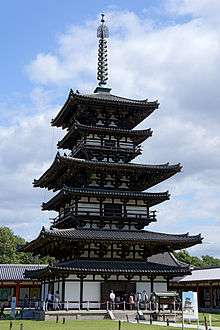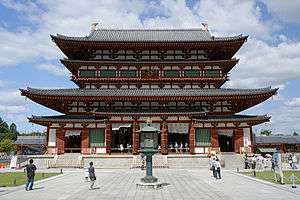Yakushi-ji
| Yakushi-ji 薬師寺 | |
|---|---|
|
The Golden Hall (kondō) at Yakushi-ji | |
| Basic information | |
| Location | 457 Nishinokyō-chō, Nara, Nara Prefecture |
| Affiliation | Hossō |
| Deity | Yakushi Nyorai (Bhaiṣajyaguru) |
| Country | Japan |
| Website | http://www.nara-yakushiji.com/ |
| Architectural description | |
| Founder | Emperor Temmu |
| Completed | 680 |
Yakushi-ji (薬師寺) is one of the most famous imperial and ancient Buddhist temples in Japan, that was once one of the Seven Great Temples of Nanto, located in Nara. The temple is the headquarters of the Hossō school of Japanese Buddhism. Yakushi-ji is one of the sites that are collectively inscribed as a UNESCO World Heritage Site, under the name of "Historic Monuments of Ancient Nara."[1]
The main object of veneration, Yakushi Nyorai, also named "The Medicine Buddha", was one of the first Buddhist Deities to arrive in Japan from China in 680, and gives the temple its name.
History

The original Yakushi-ji was built in Fujiwara-kyō, Japan's capital in the Asuka period, commissioned by Emperor Temmu in 680 to pray for recovery from illness for his consort, who succeeded him as Empress Jitō. This act of building temples in devotion to Buddhist figures was a common practice among Japanese nobility when Buddhism was first imported from China and Korea. Emperor Temmu had died by the time Empress Jitō completed the complex around 698; and it was disassembled and moved to Nara eight years after the Imperial Court settled in what was then the new capital.[2]
It has been long believed that the temple was moved to its present location in 718, following the move of the capital to Heijō-kyō known today as Nara. However, excavations of the Fujiwara-kyō Yakushi-ji site in the 1990s suggest that there may have been two Yakushi-ji at one time. The Fujiwara-kyō Yakushi-ji is also referred to as Moto Yakushi-ji (元 moto, original).
Fires destroyed most buildings of the complex in 973, and the main hall in 1528. Much hard work has been put into restoration: the main hall was rebuilt in the 1970s, and the entire temple is now completely restored.
East Pagoda
The East Pagoda (東塔 Tō-tō), completed in 730 during the Nara period, is the only original 8th-century structure at Yakushi-ji.[1] The structure stands at 34 metres (112 ft), and is regarded as one of the finest pagodas in Japan, representing Hakuhō to Tenpyō period architecture. The East Pagoda has just three stories, but seems to have six because of the presence of inter-storey pent roofs (mokoshi). The structure is topped by a distinctive globe-shaped finial. The East Pagoda was disassembled for repair work from 1898-1900, and disassembled again in 2012. The central pillar of the pagoda (心柱 shinbashira) had corroded, and edges of the eaves of the pagoda had sagged. A seven-storey scaffold completely surrounds the East Tower, and repair work will continue to 2018.[3][4]
Architecture
Layout
Yakushi-ji's layout is symmetrical, with two main halls and two three-story pagodas. The unique layout is also sometimes referred to as “yakushiji-style”.
Images
 Genjō-sanzōin (Xuanzang Hall)
Genjō-sanzōin (Xuanzang Hall) Daikodō
Daikodō Saitō (West Pagoda)
Saitō (West Pagoda) Tōtō and Saitō
Tōtō and Saitō Nighttime view
Nighttime view- Courtyard
 Cloister
Cloister
See also
- Bussokusekika
- Shinbashira, the central, usually suspended wooden column inside
- Nanto Shichi Daiji, Seven Great Temples of Nanto.
- List of National Treasures of Japan (temples)
- List of National Treasures of Japan (archaeological materials)
- List of National Treasures of Japan (paintings)
- List of National Treasures of Japan (sculptures)
- For an explanation of terms concerning Japanese Buddhism, Japanese Buddhist art, and Japanese Buddhist temple architecture, see the Glossary of Japanese Buddhism.
Notes
- 1 2 "Yakushiji". Encyclopedia of Japan. Tokyo: Shogakukan. 2012. OCLC 56431036. Retrieved 2012-06-06.
- ↑ Matsuzawa, Midori. "Yakushi-ji' a unique chance on a grand scale," Daily Yomiuri Online. April 4, 2008.
- ↑ 薬師寺東塔修理 1世紀ぶり解体 [Repair to Yakushi-ji East Pagoda, disassembled again 100 years later]. Tōkyō Shinbun (in Japanese). Tokyo: Chūnichi Shinbunsha. June 5, 2012. Retrieved June 6, 2012.
- ↑ 薬師寺東塔の解体修理始まる 無事祈り現地で法要 [Repair work begins on Yakushi-ji East Tower, memorial service held to pray for safety on work site]. Nihon keizai shinbun (in Japanese). Tokyo: Nikkei. June 4, 2012. Retrieved June 6, 2012.
External links
| Wikimedia Commons has media related to Yakushiji. |
- Yakushi-ji Homepage (Japanese)(Flash)
- Yakushiji - An Imperial Healer
- Japan Guide
- Yakushiji Annual Events
- Photos of Yakushiji
Coordinates: 34°40′6.08″N 135°47′3.52″E / 34.6683556°N 135.7843111°E
